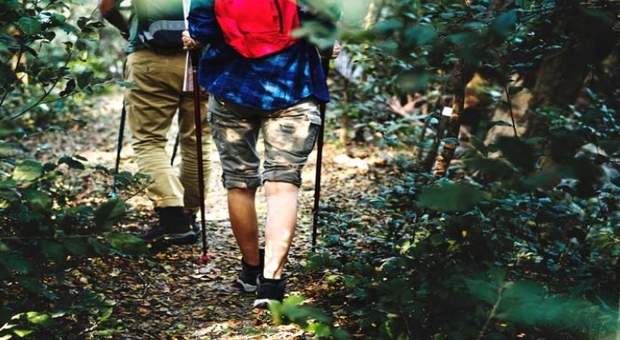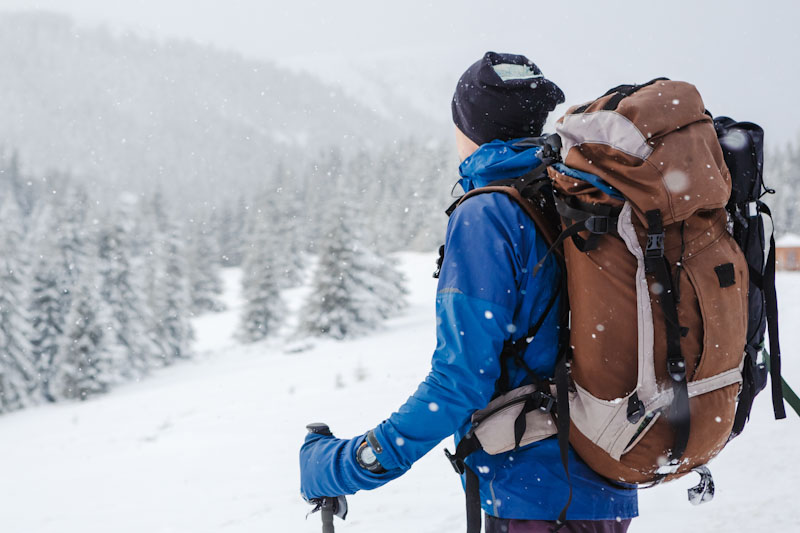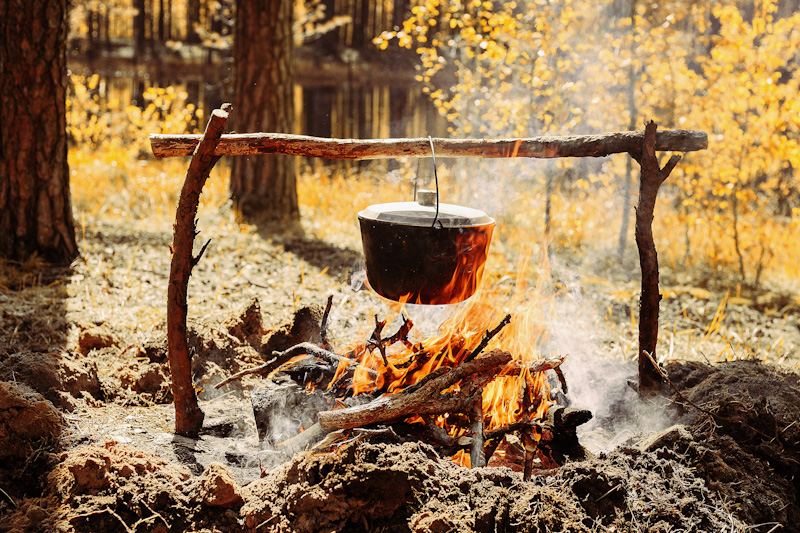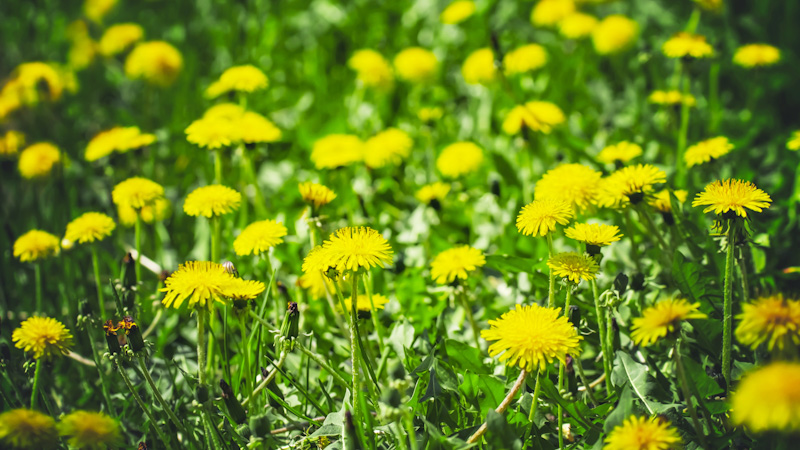On the bright side, our National and State Parks are booming.
And is it any wonder? The National Park System (NPS) is an adventurer’s paradise. It has over 18,000 miles of walking trails. With countless scenic lakes, mountains, rivers and cave systems to explore. As well as 100’s of historic landmarks, heritage sites and battlefields and much more.
But what does all this mean?
Well, more people than ever before are now getting out into the wilderness, to walk, fish and camp. In fact, over the last 100 years, the NPS has seen a 300+% increase in recreational visits. Having a fit and active lifestyle is great.
There’s just one ‘slight’ problem.
All too often, hikers are heading off into the great outdoors without the right skills or equipment. They’re getting lost, hurt or risking starvation. But why do they resort to the ultimate in human stupidity and arrogance?
Put simply: “convenience”.
They see a gorgeous mountain or valley on social media, and just head out. Without any proper research or preparation. Not planning their route or taking the correct safety advice. Often they rely on a cell phone as the only safety device. Ignorant of the fact that signals can be weak in distant areas, and batteries need constantly recharging. What started out as a day trip walking on trails, can rapidly turn into a nightmare lasting days on end.
Read on to find tips on how you can survive when your food runs out..
Survival Priorities and The Rules of 3’s
In real survival situations people often find themselves ill-prepared in a place they didn’t ever expect. They “assumed” they could easily return to civilization before it got dark. But, they never took any extra food, clothes or blankets to prepare for the cold or an overnight stay outdoors.
There are 4 levels of the Survival Rules of 3’s, which state that you can survive for up to:
- 3 Minutes without air or in ice cold water
Any condition threatening your breathing is an immediate survival situation. For instance, anyone with asthma or who has allergic reactions needs to carry medication prescribed by their doctor.
- 3 Hours without shelter in a severe environment
Make sure you’re not in danger from exposure to heat or cold. For example, the ability to build a fire and packing warmer clothes.
- 3 Days without water
- 3 Weeks without food
Before heading out, always ask yourself how much food or water would you take if you wouldn’t get back before dark?
The rule is not going to be accurate in all cases. For instance, James Scott survived 43 days in the snowy Himalayas and only ate melted snow, one caterpillar and two chocolate bars.
But it does allow you to focus on the most important issues that require immediate attention first.
For example, as a first step, build a shelter to protect yourself from the wind and rain. Stay warm, by building a fire. Next, find drinking water, or purify the water source you already have. Then, find food in the local area.
How To Identify Edible Plants In The Wild
So you ate your last granola bar three days ago. Now you’re literally ravenous. You need to maintain your strength. The plants around are beginning to look more appetizing. We know some plants are full of vitamins. Whilst others can make you ill or even be fatal. So what exactly can you chew on?
Here’s how you can find greenery which can provide the calories you need to keep going (without killing you).
Which Plants Are Poisonous?
You may have no clue on how to identify the hundreds of species of poisonous plants out there. But, a good guideline when foraging, is to never eat anything you don’t 100% recognize. Also, if you require ongoing medication, the chemicals contained within plants may cause side-effects, so always ask your doctor first.
There are some telltale signs to help you determine which plants are not safe to eat. Probably the most common sign of a poisonous plant is the color red. Plants that have high toxicity levels often have bright colored red leaves and red buds or berries. While this is not always the case, it’s better to stay on the side of caution.
The second indication that a plant may be lethal is it’s smell. If a plant gives off a foul odor, there is a good chance that it’s not good to eat. Another sign is an almond-like scent coming from the leaves or the main woody stem or trunk.
A plant with three-leaved formations is another sign that it’s deadly. Species like Poison Oak and Poison Ivy both have leaves which are be easy to spot. If ingested, these plants can cause serious harm. Even skin contact can cause rashes and blisters.
Other key indicators of plants to avoid, include: discolored or whitish sap, soapy or bitter tasting, thorns or fine hairs and bulbs, beans or pods containing seeds.
The traits listed above are only guidelines. If you come across an unknown plant and want to be completely confident it’s edible, it’s best to carry out the Universal Edibility Test as below.
Universal Edibility Test
Pre-requisites: Time (you’ll need at least 24 hours). A plant that is plentiful supply. No intake of food or drink for 8 hours.
This test requires a plant to be broken into separate parts and individually testing them over a day.
- Separate The Plant
Separate the plant into 5 parts: leaves, stems, roots, buds and flowers. If any part shows signs of insects, worms or parasites, throw it away and find another.
- Contact Test
Take just one plant part, e.g. leaves. Crush it and rub it along your inner arm or wrist (5-10 mins is Ok). Next, wait 8 hours; during this time you can’t consume anything, except water.
If you can see or feel any adverse reaction on your arm, e.g. redness, burning or bumps, then stop. You may want to move onto another plant part.
- Cook Test
If you have a means to start a fire and some clean water, then boil the plant part. Hold the plant (boiled or raw) to your lip. Wait 3 mins. If there’s a burning or any other unpleasant reaction, try testing with another part. Move onto the next step if you experience no reaction.
- Taste Test
Place the same plant part on your tongue. Wait 10 to 15 mins. Feel any tingling or burning sensation? If yes, rinse your mouth out with clean water.
- Chew Test
Chew the plant fully, but don’t swallow. Wait for 10 minutes. If you feel any sign of burning, rinse your mouth out with water.
- Swallow Test
Now you can swallow that piece of plant. Next is an 8 hour wait, during which you can only drink water. If you start feeling sick, take in lots of water, causing you to vomit.
- Chow Test
Take a quarter cup of the same plant part, prepare it as in step 3. Eat it and wait 8 hours. You can drink water, but no other food should be consumed. Any adverse signs like nausea, follow the above steps.
If at any stage of the above tests, you’re not feeling well, have a burning/tingling feeling in your mouth or on your lips/skin, then stop! Clean the affected area with purified water and start again with another plant part.
If you’re still feeling Ok, well done! Now you can safely assume this part of the plant can be eaten (if you prepared it in the same way). You’ll still need to test the other parts of the same plant, to find out if they are Ok to eat. Yes, it can be time-consuming, but it could be a real life saver, when you have no food.
5 Poisonous Plants To Definitely Avoid
While there are a great variety of wild plants you can eat, there are quite a few that are fatal. Below we will learn about some of the most common poisonous plants.
Deadly Nightshade (also known as Belladonna, Atropa Belladonna)
The pretty bell-shaped purple flowers of this shrub usually bloom between June and August. Found in some parts of North America, although not a native species. Looks can be deceiving, as it’s leaves and berries are highly poisonous even in small doses.
Poison Ivy
Poison Ivy is common throughout most of the United States. Contact with the plant can cause a nasty skin rash, leading to redness, blistering and swelling. The severity of allergic reaction depends on how much direct contact you have. Avoid touching the stem, leaves or berries.
Datura (other common names include Devil’s Trumpets, Devil’s Weed, Jimson Weed)
These flowering plants are highly toxic (particularly their flowers and seeds) and can cause serious illness and death. The level of toxicity, however, can vary depending on the age of the plant.
Water Hemlock (or Cicuta)
One of most poisonous plants in North America. These herbaceous plants are found growing in or around streams, ponds and marshy areas. Similar in appearance to water parsnip and wild celery. Eating any part of Cicuta (particularly the root) can lead to a number of symptoms, from rapid breathing, convulsions, violent tremors to rapid death.
Oleander (also called Nerium)
A small tree characterized by thin grey/green pointed leaves and clusters of rose colored flowers. Both leaves and stems contain a poisonous sap. Symptoms of poisoning include salivation, seizures and finally death.
7 Common Edible Plants
Forage for Nuts
Hickory Nuts
The Hickory Tree is native the US, Canada and Mexico. It’s fruit, the Hickory nut, tastes very similar to pecans. You can pluck these sweet, protein rich snacks right out of their shells. Make sure you really have a Hickory. They have a double shell, i.e. you can peel off the outer husk to reveal a multi-chambered (walnut-like) nut shell inside. And avoid the similar looking (but poisonous) buckeyes, which have solid nut (almond-like) inside.
Pine Nuts
Found all over North America, the most common are the pinyon pines (Colorado, single-leaf and the Mexican pinyons). Containing over 60% fat, 13% protein, 13% carbohydrates, alongside numerous vitamins and minerals, these nutritious tree nuts are also gluten-free. Unshelled nuts are compact and colored bright brown, and when dropped from a height produce a metallic sound. Avoid nuts that are rancid smelling, or have mold, spots or cracks.
Beech Nuts
The American beech can often be seen across the eastern side of North America, south east Canada, and also Mexico. In autumn, its edible fruit (beechnuts) fall from the tree. The delicious nuts of the beech tree have been used for centuries by ancient cultures as an excellent plant food source. They contain 4 percent of protein and 22 percent of healthy fats.
Bite into Berries
Blackberries
These berries are widespread enough to be found all over the United States. A cup blackberries contain 62 calories, with half your body’s daily Vitamin C and one-third of your daily Vitamin K requirements. As well as the sweet dark purple fruit, the dried leaves can be made into a mild tasting.
Raspberries
Wild raspberry plants have pointed leaves with sides which are saw-toothed and hairy on top. This plant blooms with small white flowers in late spring. The fruit grows on bent over canes, and are small and round shaped. They come in a number of different colors (red, purple, black, white and yellow). Each fruit consists of lots of smaller parts (called drupelets). The surface is covered in tiny hairs. As well as the berries, tea can be made from the leaves.
Elderberries
This small shrub grows throughout eastern regions of the United States. Elder bushes produce white flowers which ripen to form large clusters of small, round black and purple berries around summer. Elderberries are high in Vitamin C, B6 and calcium.
A cupful of the ripe berries can yield 105 calories. Don’t forget to avoid the rest of the plant (leaves, branches, flowers, seeds, roots, etc.), as they can contain toxins.
Mulberries
Mulberries grow wild in many temperate regions around the world including the United States, where the red mulberry is particularly common in eastern states. Although in appearance, the dark purple and black fruit looks like blackberries, instead of growing on thorny bushes, the berries hang from trees. The ripe fruit are sweet and nutritious too; at 60 calories for each cup-sized serving, and over 80% your daily Vitamin C needs.
One Last Thing
Finally, remember to take a few essentials on your next big adventure. Your survival pack should include a GPS, matches, flashlights, blankets, extra clothes (in cold or wet climates), radio and whistle.
And of course, some extra food and water!























William Glass | March 10, 2019
|
I was watching Carson one night , and he had on a professional big game hunter and guide. Carson ask him about how to “survive” in the jungle. The answer was priceless (and applies to any wilderness scenario.
1. Never go into the jungle at night. Bad idea.
2. Never go into the jungle in the daytime.
3. If you se the locals running out of the jungle, you run with them and when they stop, you ask “What are we running from”.
R. | March 11, 2019
|
Years ago I was in central America delivering a helicopter. The former Army pilot who was with me was on his first civilian contract. He was wearing body armor when we were in the city. He asked why I was “naked” and I told him when the locals take cover, so will I. They know the area and I don’t. Wasn’t my first rodeo.
Rod Burns, Quadra Island, Canada | March 11, 2019
|
I am a wild crafter, picking hundreds of pounds of berries, in season. At our country market, I very often hear : Red you are dead – Purple is poisonous!
YIKES – not totally true!
:- RED Edibles: Raspberries, Strawberries, Huckleberries (Western are red), red currents, Salmonberries, Thimbleberry,
Red being poisonous: Sumac, Devils Club, Poison ivy, West Coast Elderberry ( needs to be cooked first – caution still advised)
Purple Edibles:: Eastern Elderflower, Salal (Western Coast berry), blue berries, Oregon Grape, Saskatoon Berry (Service Berry back East)
Red / Black Edibles: Himylan Blackberry (spelling), Cut Leaf / Evergreen Blackberry,
Rocky | March 11, 2019
|
You are right on point. The problem is people who don’t have a clue?
Brian | March 12, 2019
|
@Rod Burns
Good list of non-poisonous red plants but you actually ought to have the sumac on that list. Poison Sumac is the one with white berries and is a member of the same family as poison ivy. Other sumacs, such as staghorn, smooth, or winged, are a different family(Rhus as opposed to Toxicodendron) and the red berries are well known for the citrus-like flavor and used to make a delicious tea.
Another point of contention is with the author’s claim regarding 3 leaves always being a sign of poison. Gout weed(ground elder) is a 3 leaved plant and is extremely nutritious with a ling history of use as a food source.